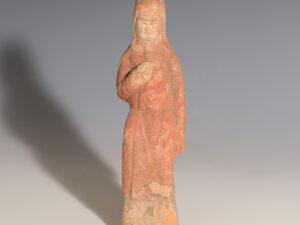Grave goods were an important status symbol in ancient China, with their purpose to accompany the deceased in their travels through the afterlife. Figures of this type are called mingqi (冥器) in Chinese and usually depict servants and court attendants, soldiers, musicians and dancers, and different animals. The size and number of the figures in a grave depended on the rank of the deceased. As in life, attendant figures were supposed to stay nearby their master, waiting to fulfil the desires and needs of the deceased. Such figures were made for the service and entertainment of the owner, ensuring that their journey in the underworld was a happy one. Ceramic tomb attendants seemed to have first appeared during the Western Han Dynasty. However, it is during Tang China that the cultural tradition of displaying wealth in elite tombs reached its peak, with an increased production of ceramic statuettes, such as this fine example. Interestingly, the attire worn by the figure, known in Ancient China as beizi, was worn by both men and women during the Sui and Tang Dynasties, while the hairstyle is typical of court ladies.
To discover more about Chinese terracotta statuettes, please visit our relevant blog post: Terracotta Tomb Attendants.
























